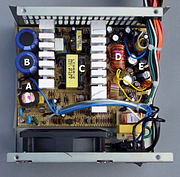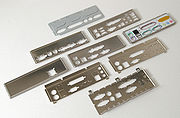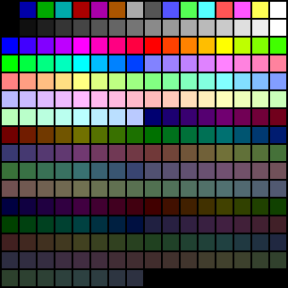The ATX (for Advanced Technology Extended) form factor was created by Intel in 1995. It was the first big change in computer case and motherboard design in many years. ATX overtook ATmicroATX, FlexATX and mini-ITX) usually keep the basic rear layout but reduce the size of the board and the number of expansion slot positions. In 2003, Intel announced the BTX standard, intended as a replacement for ATX. As of 2007 the ATX form factor remains the industry standard for do-it-yourselfers; BTX has however made inroads into pre-made systems, being adopted by computer makers like Dell, Gateway, and HP. completely as the default form factor for new systems. ATX addressed many of the AT form factor's annoyances that had frustrated system builders. Other standards for smaller boards (including [update]
The official specifications were released by Intel in 1995, and have been revised numerous times since, the most recent being version 2.2,[1] released in 2004.
A full size ATX board is 305 mm wide by 244 mm deep (12" x 9.6" ). This allows many ATX form factor chassis to accept microATX boards as well.
Power supply

Main changes from AT design
AT-style computer cases had a power button that was directly connected to the system computer power supply (PSU). The general configuration was a double-pole latching mains voltage switch with the four pins connected to wires from a four-core cable. The wires were either soldered to the power button (making it difficult to replace the power supply if it failed) or blade receptacles were used.

An ATX power supply does not directly connect to the system power button, allowing the computer to be turned off via software. However, many ATX power supplies have a manual switch on the back to ensure the computer is truly off and no power is being sent to the components. With this switch on, energy still flows to the components even when the computer appears to be "off." This is known as soft-off or standby and can be used for remote wake up through Wake-on-Ring or Wake-on-LAN, but is generally used to power on the computer through a front switch.
Power connection to the motherboard
The power supply's connection to the motherboard was changed. Older AT power supplies had two similar connectors that could be accidentally switched, usually causing short-circuits and irreversible damage to the motherboard. ATX used one large, keyed connector instead, making a reversed connection very difficult. The new connector also provided a 3.3 volt source, removing the need for motherboards to derive this voltage from one of the other power rails. Some motherboards, particularly late model AT form factor offerings, supported both AT and ATX PSUs.
Because the ATX PSU uses the motherboard's power switch, turning on the power in situations that do not utilize an ATX motherboard is possible by shorting the green wire from the ATX connector to any black wire on the connector (or ground). This allows re-use of an old PC power supply for tasks other than powering a PC, but one must be careful to observe the minimum load requirements of the PSU.
Airflow
ATX was originally designed with the power supply drawing air into the case and exhausting it down onto the motherboard. The plan was to deliver cool air directly to the CPU's and power regulation circuitry's location, which was usually at the top of the motherboard in ATX designs. This was not particularly useful for a variety of reasons. Early ATX systems simply didn't have processors or components with thermal output that required special cooling considerations. Later ATX systems with significantly greater heat output would not be aided in cooling by a power supply, because it would be delivering its often significantly heated exhaust into the case. As a result, the ATX specification was changed to make PSU airflow optional.[1]
ATX power supply revisions
Original ATX
ATX, introduced in late 1995, defined three types of power connectors:
- 4-pin peripheral connector (commonly but innacurately known as "MOLEX") - transferred directly from AT standard
- 4-pin floppy connector - transferred directly from AT standard
- 20-pin main motherboard connector
The power distribution specification defined that most of PSU's power should be provided on 5V and 3.3V rails, because most of motherboard and adjoined electronical components (CPU, RAM, chipset, PCI, AGP and ISA cards) used 5V or 3.3V for power supply. The 12V rail was only used by fans and motors of peripheral devices (HDD, FDD, CD-ROM, etc.).
The original ATX power supply specification remained mostly unrevised until year 2000.
ATX12V 1.x
While designing the Pentium 4 platform in 1999/2000, the standard 20-pin ATX power connector was deemed inadequate to supply increasing electrical load requirements. So, ATX was significantly revised into ATX12V 1.0 standard (that is why ATX12V 1.x is sometimes inaccurately called ATX-P4). ATX12V 1.x was also adopted by Athlon XP and Athlon 64 systems.
ATX12V 1.0
The main changes and additions in ATX12V 1.0 (released in February 2000) were:
- An extra 4-pin, 12-volt connector. Its purpose is to exclusively power the CPU (in original ATX, the CPU was powered from the 5V rail).
- A supplemental 6-pin AUX connector providing additional 3.3V and 5V supplies to the motherboard, if it needed it. Although it was present on every ATX12V 1.x PSU (as required per standard), it was rarely implemented on motherboards, because it was not needed. Only some dual processor motherboards used it.
- Increased the power on the 12V rail (power on 5V and 3.3V rails remained mostly the same).
This is a minor revision from August 2000. The power on 3.3V rail was slightly increased, among other much lesser changes.
ATX12V 1.2
A relatively minor revision from January 2002. The only significant change was that the -5V rail was not required anymore (it became optional). This voltage was very rarely used, only on some old systems with some ISA add-on cards.
ATX12V 1.3
Introduced in April 2003 (a month after 2.0). Lot of relatively minor changes. Some of them are:
- Slightly increased the power on 12V rail.
- Defined minimal required PSU efficiencies for light and normal load.
- Defined acoustic levels.
- Introduction of Serial ATA power connector (but defined as optional).
ATX12V 2.x
ATX12V 2.x brought a very significant design change regarding power distribution. When analyzing the then-current PC architectures' power demands, it was determined that it would be much easier (both from economical and engineering perspectives) to power most PC components from 12V rails, instead of from 3.3V and 5V rails.
ATX12V 2.0
The above conclusion was incorporated in ATX12V 2.0 (introduced in February 2003), which defined quite different power distribution from ATX12V 1.x:
- Most power is now provided on 12V rails. The standard specifies that two independent 12V rails (12V2 for the 4 pin connector and 12V1 for everything else) with independent overcurrent protection are needed to meet the power requirements safely (some very high power PSUs have more than two rails, reccomendations for such large PSUs are not given by the standard).
- The power on 3.3V and 5.V rails was significantly reduced
- The main ATX power connector was extended to 24 pins (it is backwards compatible). The extra four pins provide one additional 3.3V, 5V and 12V circuit.
- The 6-pin AUX connector from ATX12V 1.x was removed because the extra 3.3V and 5V circuits which it provided are now incorporated in the 24-pin main connector.
- Serial ATA power cable is required.
- Many other specification changes and additions.
| Color | Signal | Pin | Pin | Signal | Color |
|---|---|---|---|---|---|
| +3.3 V | 1 | 13 | +3.3 V sense | ||
| +3.3 V | 2 | 14 | −12 V | ||
| Ground | 3 | 15 | Ground | ||
| +5 V | 4 | 16 | Power on | ||
| Ground | 5 | 17 | Ground | ||
| +5 V | 6 | 18 | Ground | ||
| Ground | 7 | 19 | Ground | ||
| Power good | 8 | 20 | −5 V (optional) | ||
| +5 V standby | 9 | 21 | +5 V | ||
| +12 V | 10 | 22 | +5 V | ||
| +12 V | 11 | 23 | +5 V | ||
| +3.3 V | 12 | 24 | Ground |
ATX12V v2.1
This is a minor revision from March 2005. The -5V rail was completely removed from the specification. The power was slightly increased on all rails.
ATX12V v2.2
- Main Power Connector changed from 20 pin to 24 pin to support PCI-Express requirements.
- Minor changes.
ATX power supply derivatives
This is an ATX12V power supply derivative made by AMD to power its Athlon MP (dual processor) platform. It was used only on high-end Athlon MP motherboards. It has a special 8-pin supplemental connector for motherboard, so an AMD GES PSU is required for such motherboards (those motherboards will not work with ATX(12V) PSUs).
EPS12V
Defined in SSI, and used by some (Xeon and Opteron) systems. It has 24 pin main connector, 8 pin secondary connector, optional 4 pin tertiary connector.
Recent specification changes and additions
Because video card power demands have dramatically increased over the 2000s, some high-end graphics cards have power demands that exceed AGP or PCIe slot capabilities. For these cards, supplementary power was delivered through a standard 4-pin peripheral or floppy power connector. Midrange and high-end PCI Express-based video cards manufactured after 2004 typically use a standard 6 or 8-pin PCIe power connector directly from the PSU.
Interchanging old/new systems with old/new PSUs
Although the ATX power supply specifications are all vertically compatible in both ways (both electrically and physically), it is not wise to mix old motherboards/systems with new PSU's, and vice versa.
There are two main reasons for this:
- The power distribution biases across 3.3V, 5V and 12V rails are very different between older and newer ATX PSU designs, as well as between older and newer PC system designs.
- Older PSUs may not have connectors which are required for newer PC systems to properly operate.
This is a practical guidance what to mix and what not to mix:
- Older systems (until Pentium 4 and Athlon XP platforms) were designed to draw most power from 5V and 3.3V rails.
- Pentium 4 and Athlon XP systems draw much more from 12V rail, instead from 5V and 3.3V rails.
- Newer systems (Athlon 64, Core Duo etc.) draw most power from 12V rails.
- Original ATX PSUs have power distribution designed for pre-P4/XP PCs. They lack the supplemental 4-pin 12-volt connector for the CPU, so they simply cannot be used with P4/XP era or newer motherboards (adapters do exist but power drain on the 12V rail must be checked very carefully if using them).
- ATX12V 1.x PSUs have power distribution designed for P4/XP PCs, but they are also greatly suitable for older PCs, since they give plenty of power (relative to old PCs' needs) both on 12V and on 5V/3.3V. Some of them might not have the -5V rail which is needed for some special add-in ISA cards. It is not recommended to use ATX12V 1.x PSUs on ATX12V 2.x motherboards because those systems require much more power on 12V, and much less on 3.3V/5V than ATX12V PSUs provide.
- ATX12V 2.x PSUs have power distribution designed for late P4/XP PCs and for Athlon 64 and Core Duo PCs. They can be used with earlier P4/XP PCs, but the power distribution will be significantly suboptimal, so a more powerful ATX12V 2.0 PSU should be used to compensate for that discrepancy. ATX12V 2.x PSUs can also be used with pre-P4/XP systems, but the power distribution will be greatly suboptimal (12V rails will be mostly unused, while the 3.3V/5V rails will be overloaded), so this is not recommended.
Special note: Proprietary brand-name or high-end workstation/server designs do not fit into these guidelines. They usually require an exactly matching power supply unit.
Issues with Dell power supplies
Older Dell computers, particularly those from the Pentium II and III times, are notable for using proprietary power wiring on their power supplies and motherboards. While the motherboard connectors appear to be standard ATX, and will actually fit a standard power supply, they are not compatible. Not only have wires been switched from one location to another, but the number of wires for a given voltage has been changed. Thus, the pins cannot simply be rearranged.[2]
The change affects not only 20-pin ATX connectors, but also auxiliary 6-pin connectors. Modern Dell systems may use standard ATX connectors.[3] Dell PC owners should be careful when attempting to mix non-Dell motherboards and power supplies, as it can cause damage to the power supply or other components. If the power supply color coding on the wiring does not match ATX standards, then it is probably proprietary. Wiring diagrams for Dell systems are usually available on Dell's support page.
[edit] Connectors
On the back of the system, some major changes were made. The AT standard had only a keyboardserial and parallel ports) had to be connected via flying leads to connectors which were mounted either on spaces provided by the case or brackets placed in unused expansion slot positions. ATX allowed each motherboard manufacturer to put these ports in a rectangular area on the back of the system, with an arrangement they could define themselves (though a number of general patterns depending on what ports the motherboard offers have been followed by most manufacturers). Generally the case comes with a snap out panel, also known as an I/O plate, reflecting one of the common arrangements. If necessary, I/O plates can be replaced to suit the arrangement on the motherboard that is being fitted and the I/O plates are usually included when purchasing a motherboard. Panels were also made that allowed fitting an AT motherboard in an ATX case. connector and expansion slots for add-on card backplates. Any other onboard interfaces (such as
ATX also made the PS/2-style mini-DIN keyboard and mouse connectors ubiquitous. AT systems used a 5 pin DIN connector for the keyboard, and were generally used with serial port mice (although PS/2 mouse ports were also found on some systems). Many modern motherboards are phasing out the PS/2-style keyboard and mouse connectors in favor of the modern standard of USB ports. Other legacy connectors that appeared on ATX motherboards but are being phased out include 25-pin parallel ports and 9-pin RS-232 serial ports. In their place are on-board peripheral ports such as Ethernet, Firewire, External SATA, audio ports (analog/S/PDIF), video (D-sub/DVI/HDMI), and extra USB ports.
Variants
There exist several ATX-derived form factors that use the same power supply, mountings and basic back panel arrangement, but set different standards for the size of the board.
| width | length | color in image | |
| FlexATX | 9 inches (228.6 mm) | 7.5 inches (190.5 mm) | |
| microATX and EmbATX | 9.6 inches (243.8 mm) | 9.6 inches (243.8 mm) | |
| Mini ATX | 11.2 inches (284 mm) | 8.2 inches (208 mm) | |
| Standard ATX | 12 inches (304.8 mm) | 9.6 inches (243.8 mm) | |
| EATX (extended ATX) | 12 inches (304.8 mm) | 13 inches (330.2 mm) | |
| WTX (workstation ATX) | 14 inches (355.6 mm) | 16.75 inches (425.4 mm) |
Prototypes
In CeBIT 2008, Foxconn unveiled a Foxconn F1 motherboard prototype, which contains 10-slots, but the board length remains the same as standard ATX motherboard.[2] In January 2008, Lian Li[3] unveiled Armorsuit PC-P80 case with 10 slots designed for the motherboard.









